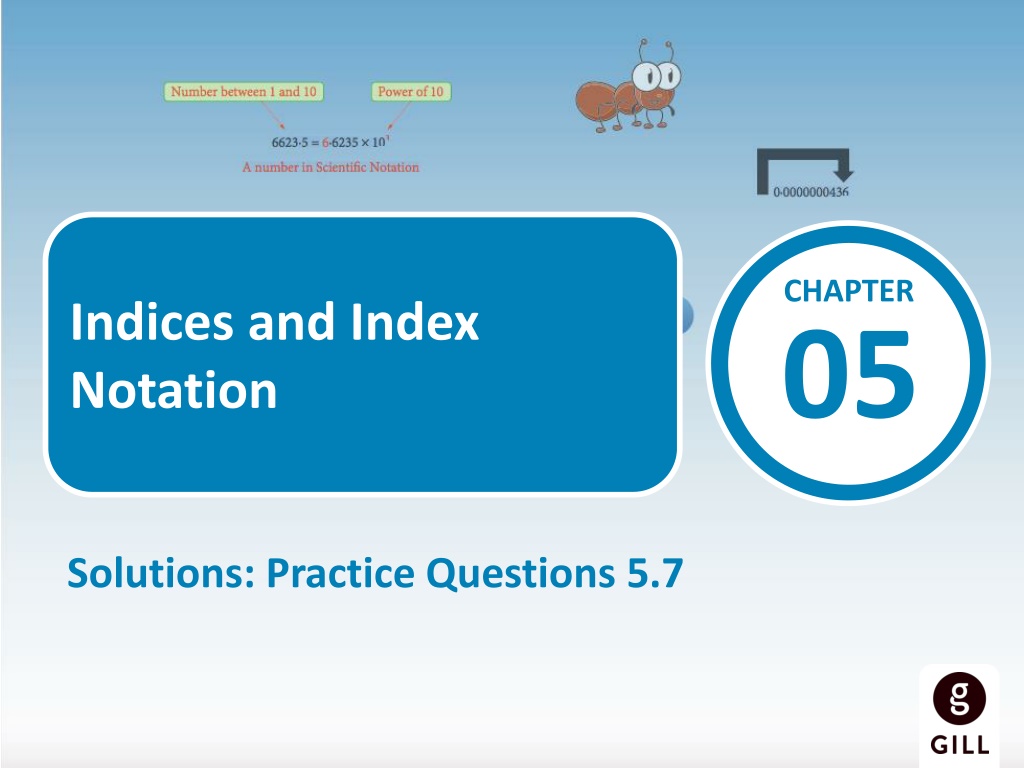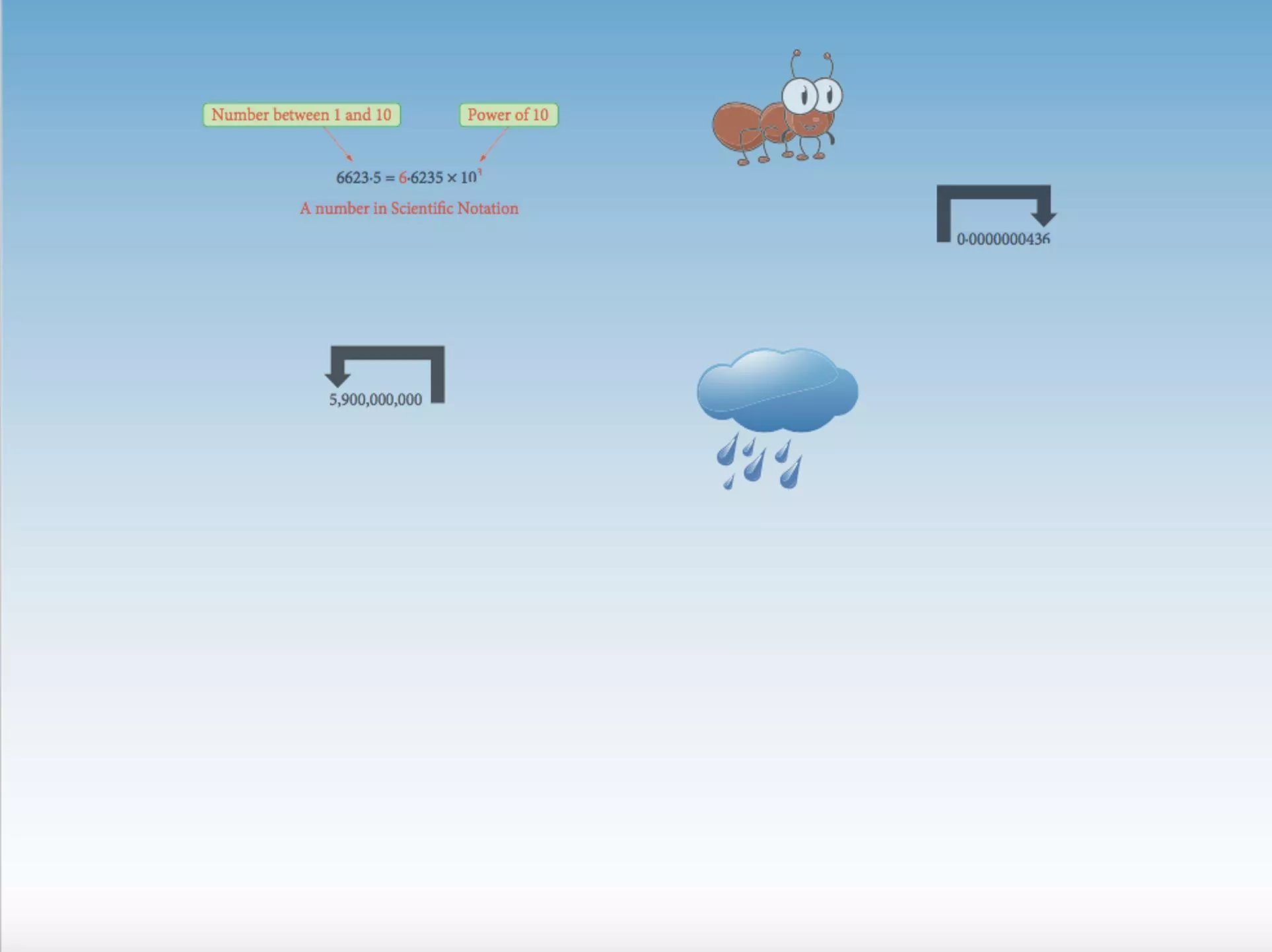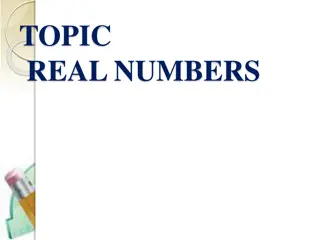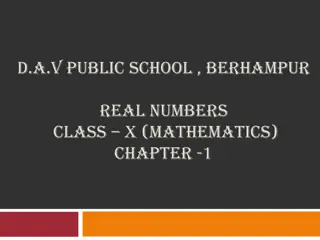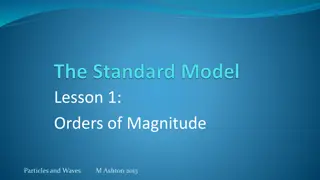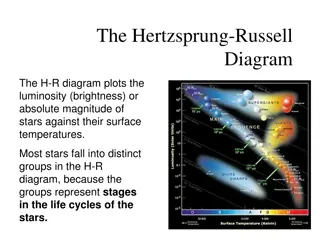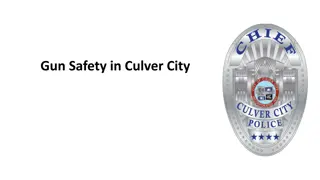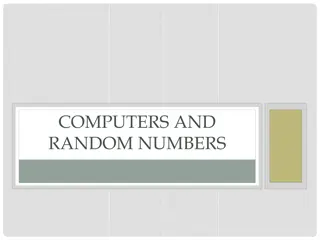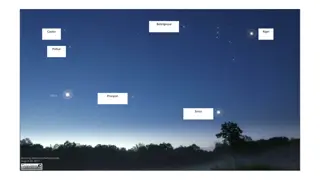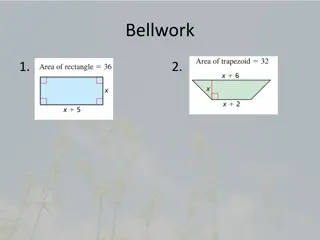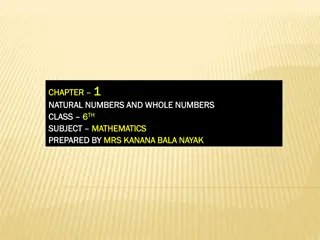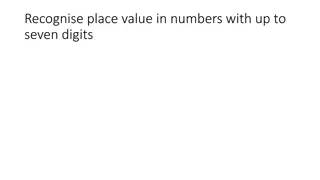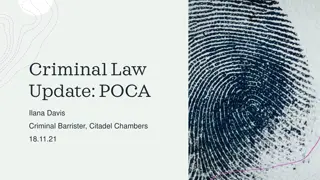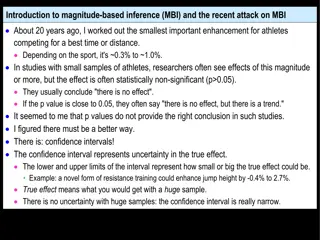Understanding Orders of Magnitude in Numbers
Explore how to determine the orders of magnitude in different numbers through a series of practice questions. Understand the significance of the power of 10 representation in indicating the scale of numbers, from large to small values.
Download Presentation

Please find below an Image/Link to download the presentation.
The content on the website is provided AS IS for your information and personal use only. It may not be sold, licensed, or shared on other websites without obtaining consent from the author. Download presentation by click this link. If you encounter any issues during the download, it is possible that the publisher has removed the file from their server.
E N D
Presentation Transcript
CHAPTER 05 Indices and Index Notation Solutions: Practice Questions 5.7
05 Practice Questions 5.7 1. How many orders of magnitude are in the following numbers? 567,230,356 (i) 567,230,356 = 5 67230356 108 Since 5 6723 > 5 Order of magnitude = n + 1 = 8 + 1 = 9
05 Practice Questions 5.7 1. How many orders of magnitude are in the following numbers? 123,456 (ii) 123,456 = 1 23456 105 Since 1 23456 < 5 Order of magnitude = n = 5
05 Practice Questions 5.7 1. How many orders of magnitude are in the following numbers? 20,987 (iii) 20,987 = 2 0987 104 Since 2 0987 < 5 Order of magnitude = n = 4
05 Practice Questions 5.7 1. How many orders of magnitude are in the following numbers? 0 000567 (iv) 0 000567 = 5 67 10 4 Since 5 67 > 5 Order of magnitude = n + 1 = 4 + 1 = 3
05 Practice Questions 5.7 1. How many orders of magnitude are in the following numbers? 0 00298 (v) 0 00298 = 2 98 10 3 Since 2 98 < 5 Order of magnitude = n = 3
05 Practice Questions 5.7 1. How many orders of magnitude are in the following numbers? 0 00000323 (vi) 0 00000323 = 3 23 10 6 Since 3 23 < 5 Order of magnitude = n = 6
05 Practice Questions 5.7 1. How many orders of magnitude are in the following numbers? (vii) 0 085 0 085 = 8 5 10 2 Since 8 5 > 5 Order of magnitude = n + 1 = 2 + 1 = 1
05 Practice Questions 5.7 1. How many orders of magnitude are in the following numbers? (viii) 0 0000076 0 0000076 = 7 6 10 6 Since 7 6 > 5 Order of magnitude = n + 1 = 6 + 1 = 5
05 Practice Questions 5.7 1. How many orders of magnitude are in the following numbers? 116 (ix) 116 = 1 16 102 Since 1 16 < 5 Order of magnitude = n = 2
05 Practice Questions 5.7 1. How many orders of magnitude are in the following numbers? 89 (x) 89 = 8 9 101 Since 8 9 > 5 Order of magnitude = n + 1 = 1 + 1 = 2
05 Practice Questions 5.7 2. Find the order of magnitude estimate for each of the following: The length of a virus is 2 8 10 3 m. (i) 2 8 10 3 Since 2 8 < 5 Order of magnitude = n = 3
05 Practice Questions 5.7 2. Find the order of magnitude estimate for each of the following: The number of atoms in 12 g of carbon is 6 1023. (ii) 6 1023 Since 6 > 5 Order of magnitude = n + 1 = 23 + 1 = 24
05 Practice Questions 5.7 2. Find the order of magnitude estimate for each of the following: A google is 10100. (iii) 10100= 1 10100 Since 1 < 5 Order of magnitude = n = 100
05 Practice Questions 5.7 2. Find the order of magnitude estimate for each of the following: The age of the universe is 14 6 billion years. (iv) 14 6 billion = 14,600,000,000 = 1 46 1010 Since 1 46 < 5 Order of magnitude = n = 10
05 Practice Questions 5.7 2. Find the order of magnitude estimate for each of the following: The diameter of a human hair is 25 10 6 m. (v) 25 10 6= 2 5 10 5 Since 2 5 < 5 Order of magnitude = n = 5
05 Practice Questions 5.7 3. The mass of an electron is 9 11 10 31 kg. The mass of a proton is 1 67 10 27 kg. What is the order of magnitude for both the mass of a proton and the mass of an electron? (i) Proton Electron 1 67 10 27 9 11 10 31 Since 1 67 < 5 Since 9 11 > 5 Order of magnitude = n + 1 Order of magnitude = n = 27 = 31 + 1 = 30
05 Practice Questions 5.7 3. The mass of an electron is 9 11 10 31 kg. The mass of a proton is 1 67 10 27 kg. Find the order of magnitude comparison between the mass of a proton and the mass of an electron. (ii) Mass of Proton Mass of Electron=10-27 10-30 =10-27-(-30) =10-27+30 =103 =1000 Therefore, a proton is 3 orders of magnitude heavier than an electron.
05 Practice Questions 5.7 3. The mass of an electron is 9 11 10 31 kg. The mass of a proton is 1 67 10 27 kg. Find the order of magnitude comparison between the mass of a proton and the mass of an electron. (Ii) Alternatively: Comparison = difference in order of magnitude of mass of Proton and Electron = 27 ( 30) = 27 + 30 = 3
05 Practice Questions 5.7 4. The population of the Earth in 2015 was 7,324,782,225. The population of Ireland was 4,635,400. What is the order of magnitude for each population? (i) Ireland Earth 4,635,400 7,324,782,225 = 4 6354 106 = 7 324782225 109 Since 4 6354 < 5 Since 7 32 > 5 Order of magnitude = n + 1 Order of magnitude = n = 6 = 9 + 1 = 10
05 Practice Questions 5.7 4. The population of the Earth in 2015 was 7,324,782,225. The population of Ireland was 4,635,400. Find the order of magnitude comparison for the population of Earth to the population of Ireland. (ii) Population of Earth Population of Ireland=1010 106 =1010-6 =104(4 Orders of magnitude)
05 Practice Questions 5.7 4. The population of the Earth in 2015 was 7,324,782,225. The population of Ireland was 4,635,400. Find the order of magnitude comparison for the population of Earth to the population of Ireland. (ii) Alternatively: Comparison = difference in order of magnitude of population of Earth and Ireland = 10 6 = 4
05 Practice Questions 5.7 5. Make an order of magnitude estimate for the following: Your age in hours. (i) Age = 17 years = 17 365 24 = 148920 hours = 1 48920 105 Since 1 4892 < 5 Order of magnitude = n = 5
05 Practice Questions 5.7 5. Make an order of magnitude estimate for the following: The number of breaths you take in a year, given an average breathing rate of 16 breaths per minute. (ii) Number of breaths in a year = 365 days 24 hours 60 minutes 16 breaths per minute = 8,409,600 = 8 4096 106 Since 8 4096 > 5 Order of magnitude = n + 1 = 6 + 1 = 7
05 Practice Questions 5.7 5. Make an order of magnitude estimate for the following: The number of heartbeats in a lifetime, given an average pulse rate of 72 beats per minute and an average life expectancy of 80 years. (ii) Number of heartbeats in 80 years 80 years 365 days 24 hours 60 minutes 72 beats per minute = 3,027,456,000 = 3 027456 109 Since 3 02 < 5 Order of magnitude = n = 9
05 Practice Questions 5.7 6. The area of Australia is 7 692 million km2. The area of Ireland is 84,421 km2. (i) Find the order of magnitude comparison between the area of Australia and the area of Ireland. Australia Ireland 7 692 million 84,421 = 7,692,000 = 8 4421 104 = 7 692 106 Since 7 692 > 5 Since 8 4421 > 5 Order of magnitude = n + 1 Order of magnitude = n + 1 = 6 + 1 = 4 + 1 = 7 = 5
05 Practice Questions 5.7 6. The area of Australia is 7 692 million km2. The area of Ireland is 84,421 km2. (i) Find the order of magnitude comparison between the area of Australia and the area of Ireland. =107 105 Area of Australia Area of Ireland =107-5 =102 (2 Orders of magnitude)
05 Practice Questions 5.7 6. The area of Australia is 7 692 million km2. The area of Ireland is 84,421 km2. (i) Find the order of magnitude comparison between the area of Australia and the area of Ireland. Alternatively: Comparison = difference in area of Australia and Ireland = 7 5 = 2
05 Practice Questions 5.7 6. (ii) The population of Australia in 2013 was 23 13 million. The population of Ireland in 2013 was 4 595 million. Find the order of magnitude comparison between the population of Australia and the population of Ireland in 2013. Population of Australia Population of Ireland = 23 13 million 4 595 million = 23,130,000 4,595,000 = 2 313 107 4 595 106 Since 2 313 < 5 Since 4 595 < 5 Order of magnitude = n Order of magnitude = n = 7 = 6
05 Practice Questions 5.7 6. (ii) The population of Australia in 2013 was 23 13 million. The population of Ireland in 2013 was 4 595 million. Find the order of magnitude comparison between the population of Australia and the population of Ireland in 2013. Population of Australia Population of Ireland =107 106=107-6=101 (1 Order of magnitude).
05 Practice Questions 5.7 6. (ii) The population of Australia in 2013 was 23 13 million. The population of Ireland in 2013 was 4 595 million. Find the order of magnitude comparison between the population of Australia and the population of Ireland in 2013. Alternatively: Comparison = difference in order of magnitude of population of Australia and Ireland = 7 6 = 1
